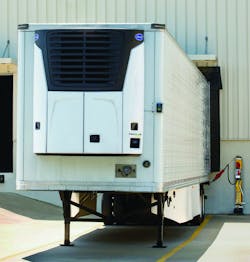Hardware Report: Refrigeration
Fuel saving and environmental compliance needs as well as food safety regulations continue to increase demand for efficient and cost-effective truck and trailer refrigeration technologies.
“Last-mile delivery can compromise as much as 28% of the cost of delivering refrigerated products, so cold plate refrigeration systems are getting a lot of attention for their ability to improve efficiency,” says Jeffrey Caddick, CEO and owner of Hercules Manufacturing. “Cold plate refrigeration is cost-effective on the front end, has a low cost of operation that is not tied into the price of diesel
fuel, and has a low cost of maintenance.”
In general, cold plate refrigeration systems utilize plates that are filled with fluid designed to freeze at a specific temperature. The plates, which are typically installed in a bank (blower unit) attached to the front wall of a delivery truck or mounted to the ceiling or sidewalls, store a set amount of Btu holdover for maintaining the desired temperature on a defined route.
These systems are plugged into shore power overnight, powering up a condensing unit that pumps refrigerant through the plates and freezes the fluid to maintain temperature the next day. In the morning, the cold plate refrigeration system is unplugged from shore power and in the case of a delivery truck, it is equipped with a blower unit. Thermostatically controlled fans cycle on and off as needed to maintain a constant temperature throughout the truck body for the duration of the route.
Cold plate refrigeration offerings from Hercules include systems for frozen and medium-temperature applications in single- and multi-temp designs. Johnson Truck Bodies offers its AE Series and EMX Series systems of free-hanging cold plates mounted on ceilings or walls and an evaporator-blower to maintain temperature. Morgan Corp.’s solution uses an electrically driven, front- or under-body compressor to cool the cold plate system.
A new development in refrigeration technology is solar panels designed to charge traditional refrigeration unit batteries. Carrier Transicold’s thin-film flexible solar panels provide up to 1.8 amps per hour and are compatible with 12-volt wet cell and absorbent glass mat batteries. The company’s standard panel for trailer roof installations measure 26 x 41 in. and are less than one-eighth of an inch thick.
Thermo King’s ThermoLite solar panels come in three models and feature charge controller technology that optimizes charging from the solar array to the batteries. “Our solar panels enable telematics systems to monitor assets over long periods of time, even when the transport refrigeration unit is off, while also safeguarding the health of the battery,” says Paul Kroes, solar business development manager.
Thermo King traditional trailer refrigeration units include the Precedent S-600 single-temp and S-600M multi-temp models. The SmartPower electric standby system option allows the unit to run on electric power in addition to standard diesel engine power.
Carrier Transicold’s trailer products include the hybrid diesel-electric Vector Series with built-in electric standby in single- and multi-temp models and the diesel-powered X4 Series. An engine emissions system, which is required in some systems if units are operated in California beyond seven years, is optional.
“The technologies in today’s transport refrigeration systems are designed to provide cost-efficient operation, particularly through improved fuel economy, emissions compliance, and improved performance in terms of greater capacity and, with the addition of telematics, remote monitoring and better control of refrigerated assets,” says Dave Kiefer, director of sales, marketing and product management at Carrier Transicold. “Additionally, new regulations continue driving developments affecting refrigerated transport in terms of refrigerants and how food is managed through the cold chain.”
